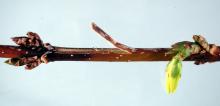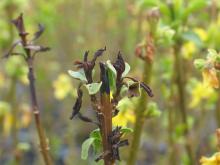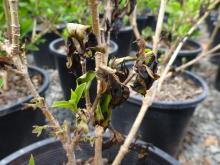Cause Pseudomonas syringae pv. syringae, a bacterium. Environmental factors play an important role with diseases caused by this bacterium. Rainy weather, winter or frost injury, and poor growing conditions favor disease development. Although the bacteria survive on the outside of the plant they must get inside and multiply in the space between plant cells (apoplast) to cause disease. These pathogenic bacteria inject several proteins and small-molecule toxins to get past host immune mechanisms. Once inside, the bacteria induce a watery, nutrient rich environment between the plant cells where they can multiply and continue colonization of the plant tissues. Bacteria also produce a protein that acts as an ice nucleus, increasing frost wounds that bacteria easily colonize and expand.
Cold temperature injury is a common diagnosis when no pathogens are recovered from injured tissue.
Symptoms Buds may fail to open or may turn black and die shortly after opening. (This symptom is similar to those of winter injury.) New shoots may develop several leaves but become water-soaked, wilt, and blacken. A shepherd's crook symptom may be seen on shoots with longer growth. Blackening may begin near the shoot tip and progress down the shoot and into lower leaves through petioles. Leaf necrosis may be restricted to the main veins but leaves then wilt and die. Flowers wilt and turn brown.
Cultural control
- Prune out and destroy infected plant parts.
- Provide good circulation around plants so they dry quicker.
- Protect from weather extremes. Plastic shelters have been as good as or better than chemical methods against the same disease on other crops.
Chemical control Apply at leaf drop in the fall and in spring when buds open. Fixed coppers (Group M1 fungicides) may be helpful, but none is specifically registered for this crop. Test the following on a few plants and observe for phytotoxicity before general use.
- Agri-Mycin 50 at 2.7 to 8 oz/100 to 300 gal water/A. Tolerant strains of the bacterium easily develop with repeated use of this product. Alternate with other bactericides to prevent or delay buildup of tolerant strains. Group 25 fungicide. 12-hr reentry.
- Bonide Copper Fungicide at 8 oz/3 gal water. Group M1 fungicide. H
- FireWall 50 WP at 1.36 oz/25 gal water. Group 25 fungicide. 12-hr reentry.
- Junction at 1.5 to 3.5 lb/A. Group M1 + M3 fungicide. 48-hr reentry.
- Phyton 27 at 1.5 to 3.5 fl oz/10 gal water. Group M1 fungicides. 48-hr reentry.
Reference Scheck, H.J., Canfield, M.L., Pscheidt, J.W., and Moore, L.W. 1997. Rapid evaluation of pathogenicity in Pseudomonas syringae pv. syringae with a lilac tissue culture bioassay and syringomycin DNA probes. Plant Disease 81:905-910.




